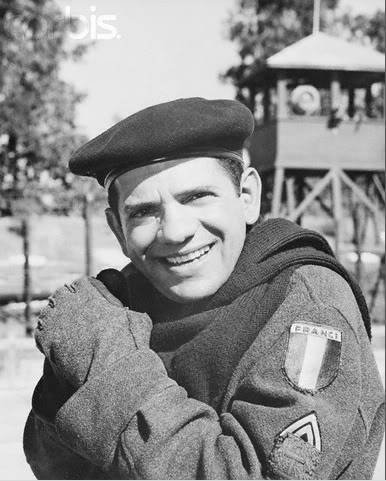 Our older brothers and fathers were in Vietnam, where casualties were mounting every day, but at home we watched wacky soldiers: McHale's Navy, No Time for Sergeants, F-Troop, Gomer Pyle USMC, The Wackiest Ship in the Army, and, the wackiest of all, Hogan's Heroes (1965-71), which also drew from the spy and "I've got a secret" craze.
Our older brothers and fathers were in Vietnam, where casualties were mounting every day, but at home we watched wacky soldiers: McHale's Navy, No Time for Sergeants, F-Troop, Gomer Pyle USMC, The Wackiest Ship in the Army, and, the wackiest of all, Hogan's Heroes (1965-71), which also drew from the spy and "I've got a secret" craze.
It was set in a World War II prisoner of war camp, Stalag 13, where the "prisoners," deliberately captured, were all spies:
Back row: LeBeau, covert operations; Colonel Hogan (Bob Crane), the leader; Kinch (Ivan Dixon), communications.
Front row: Newkirk (Richard Dawson), impersonations and con games; Carter (Larry Hovis), explosives and all things scientific.
Back row: LeBeau, covert operations; Colonel Hogan (Bob Crane), the leader; Kinch (Ivan Dixon), communications.
Front row: Newkirk (Richard Dawson), impersonations and con games; Carter (Larry Hovis), explosives and all things scientific.

The commandant, Colonel Klink (Werner Klemperer, right), was an incompetent bureaucrat. The only guard was Sergeant Schultz (John Banner, left), a sweet-tempered toymaker in civilian life, who turned a blind eye to the unusual activities ("I see nothing!"). Both were victims of circumstance, not actively evil; the villains were the Nazi higher-ups, who might discover the secret operation and shut it down.
What was the attraction for gay kids, other than the fact that the only other choices on Saturday night were The Lawrence Welk Show and the first half of a movie?
1. Lack of displayed heterosexual interest. Other entries in the spy genre, such as I Spy and Wild Wild West, involved its heroes in endless leering at bikini-clad women, but the POW camp was an all-male world, with no women visible except for Colonel Klink's secretary and an occasional female resistance agent. Hogan occasionally smooched with a woman, but no episodes involved hetero-romance.
2. Dreamy guys in the cast, especially Robert Clary. No beefcake, unfortunately -- no one as much as unbuttoned a button, even while lying around in the barracks. In fact, it's almost impossible to find nude shots of any of the cast members, even in other projects.
3. Hogan and Klink certainly weren't buddies. Klink was constantly annoyed by Hogan's irreverence. Hogan found Klink stuffy and old-fashioned (another 1960s clash between the establishment and the counterculture). Yet as they strategized against each other, or more often worked together toward some common goal, they developed a love-hate bond that one could easily see spinning into a forbidden romance. It was a pleasure to watch them interact every week.
Bob Crane (1928-1978) became so famous as Colonel Hogan that it's hard to remember his many other roles. He starred in the Disney movie Superdad (1973) and his own short-lived Bob Crane Show, guest starred on everything from Ellery Queen to Love Boat, and worked extensively in theater.
He was married twice and had five children (shown: his son Scotty), but he also had relationships with many women, and occasionally men. He was reputedly a BDSM bottom; however, no BDSM scenes appear in the hundreds of tapes he made of his sexual encounters.
When he was murdered in 1978, people speculated that it was a BDSM scene gone wrong.The main suspect, his friend John Carpenter, was acquitted on lack of evidence.
Greg Kinnear played Bob Crane in the 2002 movie Auto-Focus.



I heard that Bob Crane was into kinky sex. Did he like men and women both, or just women?
ReplyDeleteAccording to rumor, Bob Crane preferred women, but didn't mind going with whoever was interested.
DeleteThe program was called "The Wackiest Ship in the Army"' staring the super sexy Gary Collins, whom I think was gay, and who was married to Mary Ann Mobley, a former Miss America.
ReplyDeleteThis post title is a joke. The post is actually about the program called "Hogan's Heroes."
DeleteI remember the episode where they need to get an agent out of the camp, so they make everyone believe that the War is over. Klink calls headquarters for conformation, and they intercept the call and yell: "Klink, you idiot! Why are you still there! The War is over!" THe operatives pretend that they are too busy celebrating to want to leave (actually they would have to wait to be sent home). They get the agent out by asking Klink, "Can he borrow your car to drive into town?"
ReplyDeleteIt's interesting that there were 400,000 German POWS housed in America. Many of them got jobs (anything not supporting the war effort is ok, according to the Geneva Conventions). And made friends with locals. Once, a family near the New Ulm camp invited a POW to their house for dinner, and he ended up spending the night. They returned him to the camp in the morning, not realizing that there was an "escaped prisoner" alert out.
ReplyDelete